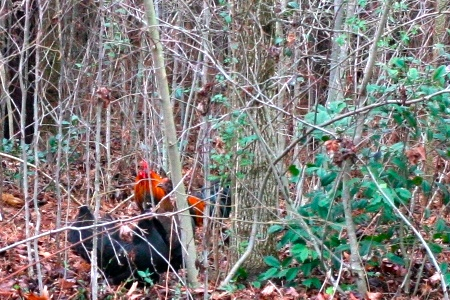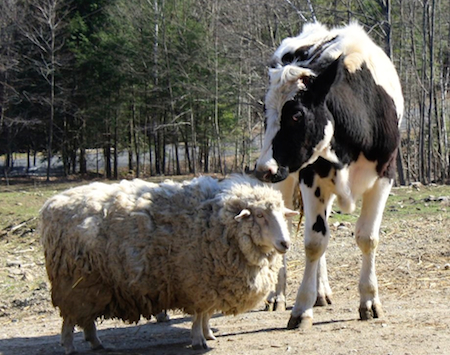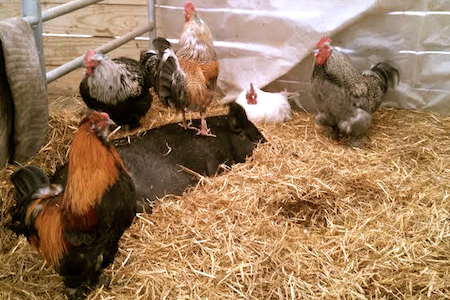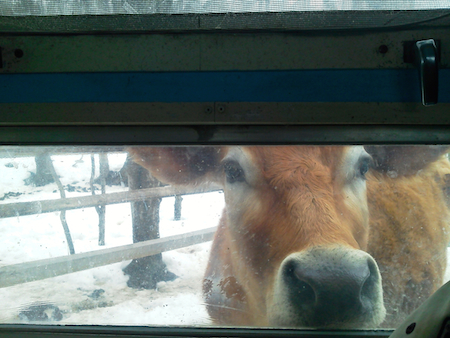The other morning, I glanced out my window to see calves bolting up a muddy driveway, glancing nervously over their shoulders at an emu. Observing the interactions of sanctuary residents with each other is one of the joys of sanctuary life.
Back when Miriam and I founded the chicken sanctuary that would grow up to be VINE, we decided that one of our tenets would be “let birds be birds.” By that we meant that we intended to set the stage for the chickens to be themselves and then get out of the way. Insofar as possible, we would offer opportunities for them to recover the essential “bird-ness” that both captivity and (especially in the case of the monstrously large chickens bred by the poultry industry) the genetic depredations of reproduction controlled by people had robbed them.
We knew that their most important relationships would be with each other, so we vowed not to give into any urge to encourage the birds to become attached to us. If anybody wanted to be our friend, that would be wonderful and we would reciprocate, but we would not seek to “tame” them in any way.
We’d also let everybody make their own decisions, insofar as this was possible to do safely within the boundaries of a world rent into bits and pieces of private property controlled by people, as well as any failures of judgement due to their own histories of circumscribed choices. So, no, we would not allow anyone to wander where other people might hurt them, and no we would not allow a newly-arrived egg factory refugee to nest for the night in a bush from which we knew (but she didn’t) that she might be snatched by a predator. But we would, and eventually did, allow birds who had or developed sufficient “bird sense” to essentially rewild themselves, sleeping in tree and foraging in the forest.
When we expanded, we had to amend our motto to include “let cows be cows,” and then “let sheep be sheep,” but the basic ethic stayed the same: Set up the sanctuary so as to offer opportunities for species-appropriate self-actualization and let folks make as many of their own decisions as possible, within the boundaries set by the state of the world and by the unique circumstances of the sanctuary (where, for example, we cannot allow cows to indulge their taste for endless helpings of emu food, not only because it would be bad for them but also because that wouldn’t be fair to the emus).
Why are the cows and the emus in conjunction with each other anyway? Because one of the most basic freedoms is the freedom of association. Humans aren’t the only ones who often like to be friends with members of other species.
I’ve written before of cow play sessions, but I didn’t mention that some sheep sometimes join in the fun. Cows and sheep play head-butting games differently (cows press their foreheads together and push while sheep tend to run and butt) but many here have figured out how to play together anyway. Adolescent cow Maddox and ram Broggy play together frequently. They’re not the only cow-sheep duo, either. While cow Coco-the-Boy and ewe Lamby are too different in size to play, they are clearly best friends.
And then there is pig Truffles and her many bird friends. Truffles came to VINE specifically so that she would not be separated from the chickens and guinea fowl to whom she was bonded. She has since made friends with a cacophony of roosters.* Visitors to the sanctuary are often surprised when what looks like a pile of hay on which several roosters are resting rises up grunting as Truffles emerges from her bed.
Relations are not always perfectly harmonious. Cows and sheep alike have persistent hankering for emu food. The emus are understandably cranky about that. Most cows find emus themselves to be unnerving. While Maddox will chomp away at the emus’ feeding station, as the big birds stand around looking annoyed, most of the cows flee when they see an emu coming, even if he or she is just taking a stroll up the driveway. It’s pretty funny to see a herd of 1,000+ lb cows making way for a gangly 150 lb bird.
But VINE is not a zoo—here, the looking goes both ways, or I guess I should say all ways. In a chapter in her anthology on The Ethics of Captivity (to which VINE’s Miriam Jones contributed a thought-provoking chapter about captivity at sanctuaries), philosopher Lori Gruen describes dignity as “a relational concept” involving a reciprocity of gaze. “Thinking of animals as things to be looked at and believing that doing so makes for an enjoyable outing,” she writes, “precludes seeing animals as having dignity.” Conversely, Gruen continues, “consenting to be what Phoebe Linden Greene calls ‘mutually viewed’ is one way of promoting animal dignity.”
Here at VINE, we not only respect nonhuman privacy but also welcome reciprocal looking. Cows Maddox, Luna, and Princess (who is also an avid bird-watcher) all sometimes watch me while I am in my trailer. When I am working outside, I will sometimes glance up to catch former fighting rooster Sharkey standing on the table, keenly observing me. Cows and chickens alike often watch, and sometimes seem to be supervising, the people cleaning the coops and barns. And I’ll never forget the time that my dear departed “brother” Thunder (a 3,000lb cow) noticed that I was having a hard time showing newly-arrived turkeys how to go into the coop for the night. He looked at me significantly and then demonstrated what he thought I should do, using his giant forehead to gently steer one of the birds toward the coop door.
(*) Yes. I did just make up a new collective noun for roosters. Do you like it?









It reminds me of a book featured on NPR last year: “The Birds of Pandemonium.”
When I looked it up just now, I found another book, titled “The Parrots of Pandemonium.”
A further search led me to this amazing list of terms for the collective of many animal species: http://blog.writeathome.com/index.php/2013/03/a-pandemonium-of-parrots-collective-nouns-for-animal-groups
Oh, by the way, pattrice, your charming blog about interspecies friendships and yummy emu food is delightful to read–and savor!